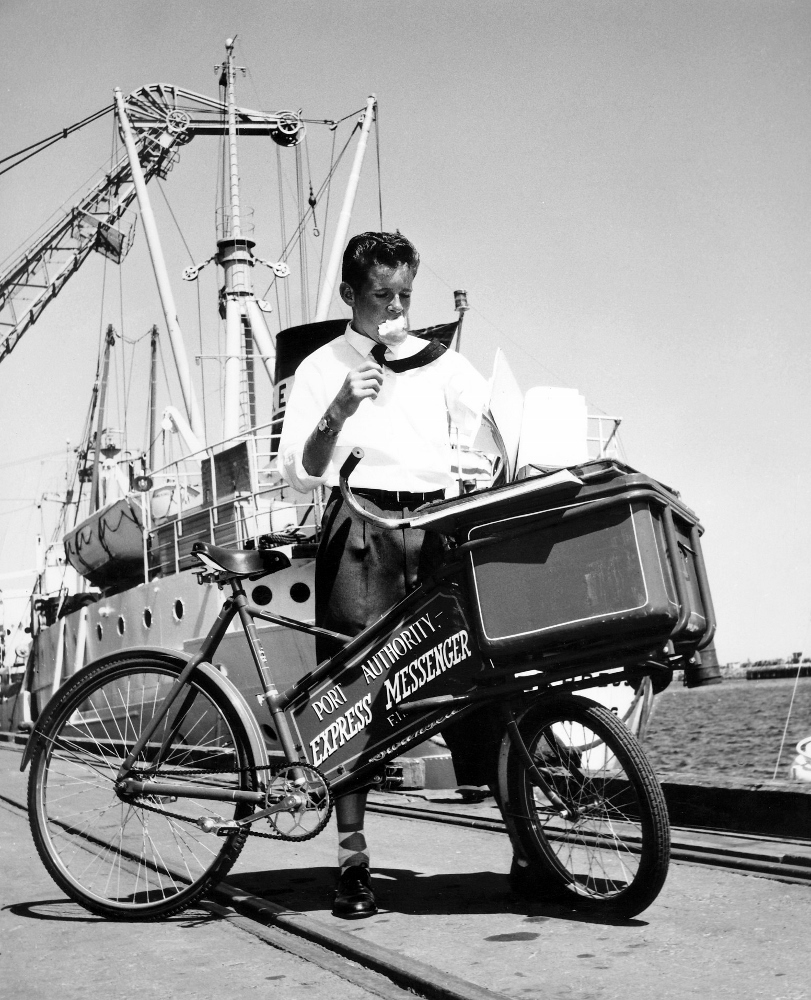Working on the waterfront
The history of Fremantle Port is a story of effort and determination on the part of the many people over the years who have been involved in its development. The port’s growth and success are also due to the commitment and effort of the thousands of people who have been employed in its day-to-day operations on land and on the water over the years.
Commercial ports such as Fremantle are dynamic workplaces, constantly evolving in response to trade and shipping trends, associated technological advances and the changes in the regulatory environment. The composition of the port’s workforce in earlier times and the conditions in which they worked presented a vastly different picture from that of today’s modern port operations. Cargo handling was labour intensive and the waterside workers worked in basic, sometimes dangerous conditions.
Gangs of lumpers, as they were known then, would descend into the holds once the ship was moored. Cargo would be winched out in slings and lowered onto the wharf. Others would sort the cargo and wheel it on trolleys into the cargo sheds. With no forklifts, it was purely manual labour. As well as the lumpers, there were other workers, for example, tally clerks, watchmen, shipwrights, plumbers, painters, mechanics - even a ratcatcher.
Over the years, as mechanisation developed, steam winches were replaced by electric versions and shore-based cranes and conveyors of various types populated the wharves. The advent of containerisation in the 1960s changed everything. At the North Quay container terminals of today, huge container cranes are used to load and unload the ships that visit. Containers are stacked using rubber-tyred gantries and fork lifts and on Victoria Quay, motor vehicle imports are driven off the giant vehicle carriers that regularly call at the port. Fremantle Ports employs a diverse workforce in areas such as port planning, environmental management, marine operations, civil and electrical engineering, information technology, finance and logistics.

1919 Wharf Riot
In 1917, the Fremantle Lumpers Union had refused to load ships they believed to be carrying supplies to Germany, an enemy nation. In response, workers from a rival union, the National Waterside Workers Union were brought in. The dispute between the two unions continued for over two years and came to a head on 4 May 1919, when supporters of the Fremantle Lumpers Union and the WA Police clashed in a bloody confrontation in what became known as the Battle of the Barricades or Bloody Sunday.
The coastal steamer SS Dimboola, which was alongside Victoria Quay, was in quarantine due to an onboard outbreak of the deadly Spanish flu which was sweeping the post-war world. A blockade had been set up by workers of the Fremantle Lumpers Union who refused to unload Dimboola’s urgently needed cargo as they claimed the ship had not been adequately quarantined to protect the community from the pandemic. The protest turned ugly when Premier Hal Colebatch intervened; he and a volunteer group were conveyed by launches down the river to Fremantle with the intent of setting up barricades on the wharf side to enable the National Waterside Workers Union workers to start unloading cargo from Dimboola. Missiles, including bricks, lumps of iron and large rocks, were thrown from the Fremantle bridges as the boats passed underneath, and from the wharfside at Victoria Quay. Mounted police attempted to push back protesters, while other officers on foot used batons and then fixed bayonets to try to prevent protesters entering the wharf area. The Riot Act was read and in the fracas that followed lumper Tom Edwards was fatally injured when he went to the aid of Lumpers’ President William Renton. Edwards died some days later in hospital.
Some form of order was restored after discussions between Fremantle Police Inspector William Sellenger, the Premier, the Lumpers Union, and the State Labor Federation. The protesters and crowds left the wharf after it was agreed that the barricades were to be withdrawn and that no NWWU workers or volunteers would step onto the wharf that day.
Tom Edwards became a symbol for Western Australia’s Labor Party and his funeral procession was attended by thousands. In his memory, Pietro Porcelli sculptured a fountain outside the Fremantle Trades Hall. It was later relocated to Walyalup Koort, on the Adelaide Street side near the Fremantle Town Hall.
References:
Waterside Workers Cafeteria
Built in 1945, this was the first building completed in Australia as part of a WWII Australian Government initiative to provide amenities for waterside workers at Australian ports. Built by the State Public Works Department as subcontractors to the Australian Government, the cafeteria was equipment by the Department of Labour and National Service and operated by the Food Services section of the department. It is a brick construction with a tiled roof. The cafeteria equipment was the most modern at the time and there was seating for up to 400 people. In later years, the building was repurposed for other uses including a gymnasium, education and security centre and a cruise terminal.
Your visit
Explore what's on at Victoria Quay and start planning your visit by 'starring' the attractions, events, walks or anything else that interests you.
See what's on





















